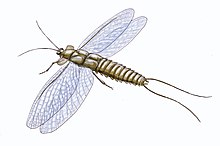Mazothairos
This article, Mazothairos, has recently been created via the Articles for creation process. Please check to see if the reviewer has accidentally left this template after accepting the draft and take appropriate action as necessary.
Reviewer tools: Inform author |
| Mazothairos Temporal range:
| |
|---|---|

| |
| Mazothairos as reconstructed by Dmitry Bogdanov | |
| Scientific classification | |
| Kingdom: | |
| Phylum: | |
| Class: | |
| Superorder: | |
| Order: | |
| Genus: | †Mazothairos Kukalová-Peck & Richardson, 1983
|
| Species: | †M. enormis Kukalová-Peck & Richardson, 1983
|
| Binomial name | |
| †Mazothairos enormis Kukalová-Peck & Richardson, 1983
| |
Mazothairos is an extinct genus of very large insect from the Carboniferous period. It was a member of the order Palaeodictyoptera and had a wingspan of about 55 centimeters (22 in), making it one of the largest-known insects.[1] It was characterized by its distinctive beak-like mouthparts which featured elongated sharp piercing stylets and possibly a sucking pump-like organ that it used to pierce plant tissues to drink their juices. Unlike those of modern sucking insects, its mouthparts were held vertically below its head.[2] It is also known for the pair of winglets on its prothorax in front of its first pair of wings, which give it the epithet of "six-winged insect".[3][4][5][6]
Mazothairos' holotype fossil was found in the Mazon Creek fossil beds in modern day Illinois, a lägerstatte formed aproximately 309 million years ago during the Pennsylvanian epoch of the Carboniferous period.[1] The formation had a tropical climate and is believed to have been part of a river delta system. The formation also preserved fossils of many other organisms, such as those of Illinois' state fossil Tullimonstrum.
References
- ^ a b Kukalová-Peck, J.; Richardson, E. S. (1983). "New Homoiopteridae (Insecta: Paleodictyoptera) with wing articulation from Upper Carboniferous strata of Mazon Creek, Illinois". Canadian Journal of Zoology. 61: 1670–1687. doi:10.1139/z83-218.
- ^ Doell, H.V; Doyen, J.T; Purcell, A.H (1998). Introduction to Insect Biology and Diversity (2nd ed.). Oxford University Press. p. 321. ISBN 0-19-510033-6.
- ^ Harald, Parzer (22 October 2018). "Enriching Undergraduate Entomology Coursework through the Integration of Evolutionary Developmental Biology". The American Biology Teacher. 80: 561–569. doi:10.1525/abt.2018.80.8.561.
- ^ Tomoyasu, Yoshinori; Wheeler, Scott R.; Denell, Robin E. (February 2005). "Ultrabithorax is required for membranous wing identity in the beetle Tribolium castaneum". Nature. 433: 643–647. doi:10.1038/nature03272.
- ^ Elias-Neto, Moysés; Belles, Xavier (3 August 2016). "Tergal and pleural structures contribute to the formation of ectopic prothoracic wings in cockroaches". Royal Society Open Science. 3. doi:10.1098/rsos.160347.
- ^ Tomoyasu, Yoshinori (January 2018). "Evo-Devo: The Double Identity of Insect Wings". Current Biology. 28. doi:10.1016/j.cub.2017.12.004.
This article, Mazothairos, has recently been created via the Articles for creation process. Please check to see if the reviewer has accidentally left this template after accepting the draft and take appropriate action as necessary.
Reviewer tools: Inform author |

